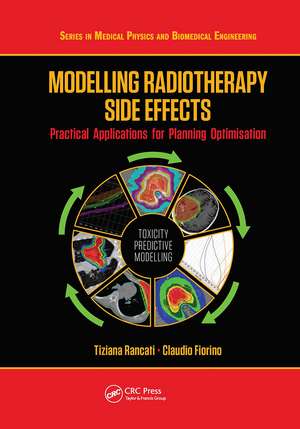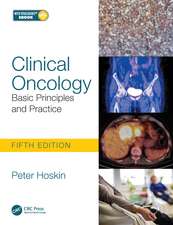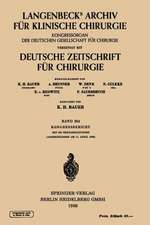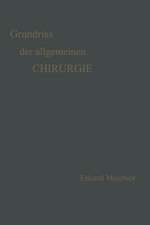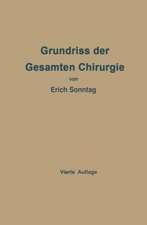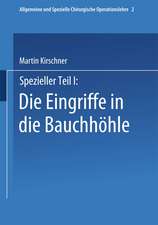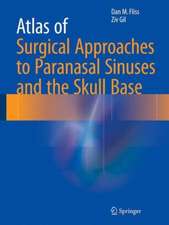Modelling Radiotherapy Side Effects: Practical Applications for Planning Optimisation: Series in Medical Physics and Biomedical Engineering
Autor Tiziana Rancati, Claudio Fiorinoen Limba Engleză Paperback – 31 mar 2021
This book provides an invaluable tutorial for radiation oncologists, medical physicists, and dosimetrists involved in the planning optimization phase of treatment. It presents a practical, accessible, and comprehensive summary of the field’s current research and knowledge regarding the response of normal tissues to radiation. This is the first comprehensive attempt to do so since the publication of the QUANTEC guidelines in 2010.
Features:
- Addresses the lack of systemization in the field, providing educational materials on predictive models, including methods, tools, and the evaluation of uncertainties
- Collects the combined effects of features, other than dose, in predicting the risk of toxicity in radiation therapy
- Edited by two leading experts in the field
Toate formatele și edițiile
| Toate formatele și edițiile | Preț | Express |
|---|---|---|
| Paperback (1) | 443.39 lei 6-8 săpt. | |
| CRC Press – 31 mar 2021 | 443.39 lei 6-8 săpt. | |
| Hardback (1) | 1304.44 lei 3-5 săpt. | +44.19 lei 6-12 zile |
| CRC Press – 10 iun 2019 | 1304.44 lei 3-5 săpt. | +44.19 lei 6-12 zile |
Din seria Series in Medical Physics and Biomedical Engineering
-
 Preț: 362.41 lei
Preț: 362.41 lei -
 Preț: 369.24 lei
Preț: 369.24 lei -
 Preț: 359.36 lei
Preț: 359.36 lei - 15%
 Preț: 673.74 lei
Preț: 673.74 lei - 5%
 Preț: 339.68 lei
Preț: 339.68 lei - 5%
 Preț: 347.04 lei
Preț: 347.04 lei - 5%
 Preț: 1304.44 lei
Preț: 1304.44 lei -
 Preț: 356.63 lei
Preț: 356.63 lei -
 Preț: 366.36 lei
Preț: 366.36 lei -
 Preț: 364.29 lei
Preț: 364.29 lei -
 Preț: 373.96 lei
Preț: 373.96 lei -
 Preț: 339.85 lei
Preț: 339.85 lei - 46%
 Preț: 352.95 lei
Preț: 352.95 lei - 23%
 Preț: 371.45 lei
Preț: 371.45 lei - 25%
 Preț: 1057.26 lei
Preț: 1057.26 lei - 5%
 Preț: 546.82 lei
Preț: 546.82 lei - 26%
 Preț: 1098.62 lei
Preț: 1098.62 lei - 49%
 Preț: 680.73 lei
Preț: 680.73 lei - 18%
 Preț: 1064.36 lei
Preț: 1064.36 lei - 22%
 Preț: 325.85 lei
Preț: 325.85 lei - 5%
 Preț: 914.71 lei
Preț: 914.71 lei - 5%
 Preț: 915.27 lei
Preț: 915.27 lei - 18%
 Preț: 1438.28 lei
Preț: 1438.28 lei - 28%
 Preț: 1046.99 lei
Preț: 1046.99 lei - 23%
 Preț: 377.01 lei
Preț: 377.01 lei - 26%
 Preț: 848.15 lei
Preț: 848.15 lei - 15%
 Preț: 489.26 lei
Preț: 489.26 lei - 18%
 Preț: 1068.15 lei
Preț: 1068.15 lei - 28%
 Preț: 603.31 lei
Preț: 603.31 lei - 26%
 Preț: 1042.56 lei
Preț: 1042.56 lei - 25%
 Preț: 851.88 lei
Preț: 851.88 lei - 5%
 Preț: 910.15 lei
Preț: 910.15 lei - 15%
 Preț: 461.03 lei
Preț: 461.03 lei - 5%
 Preț: 1038.35 lei
Preț: 1038.35 lei - 27%
 Preț: 509.61 lei
Preț: 509.61 lei - 14%
 Preț: 312.45 lei
Preț: 312.45 lei - 5%
 Preț: 747.83 lei
Preț: 747.83 lei - 27%
 Preț: 1228.34 lei
Preț: 1228.34 lei - 18%
 Preț: 1059.45 lei
Preț: 1059.45 lei - 15%
 Preț: 682.83 lei
Preț: 682.83 lei - 25%
 Preț: 1195.93 lei
Preț: 1195.93 lei - 18%
 Preț: 887.88 lei
Preț: 887.88 lei
Preț: 443.39 lei
Preț vechi: 466.73 lei
-5% Nou
Puncte Express: 665
Preț estimativ în valută:
84.84€ • 88.58$ • 70.22£
84.84€ • 88.58$ • 70.22£
Carte tipărită la comandă
Livrare economică 04-18 aprilie
Preluare comenzi: 021 569.72.76
Specificații
ISBN-13: 9780367779719
ISBN-10: 0367779714
Pagini: 494
Dimensiuni: 178 x 254 x 25 mm
Greutate: 0.86 kg
Ediția:1
Editura: CRC Press
Colecția CRC Press
Seria Series in Medical Physics and Biomedical Engineering
ISBN-10: 0367779714
Pagini: 494
Dimensiuni: 178 x 254 x 25 mm
Greutate: 0.86 kg
Ediția:1
Editura: CRC Press
Colecția CRC Press
Seria Series in Medical Physics and Biomedical Engineering
Public țintă
Professional Practice & DevelopmentCuprins
PART I: DATA AND MODELS.
The importance of the quality of data
Building a predictive model of toxicity: methods.
Potentials and limits of phenomenological models.
PART II: PREDICTING THE RISK OF TOXICITY IN PRACTICE.
Pelvis: rectal and bowel toxicity.
Pelvis: urinary toxicity and sexual dysfunctions.
Abdomen.
Optical structures and ears.
Head and neck: parotids.
Head and neck: structures involved in swallowing and nutritional problems.
Head and neck: larynx and structures involved in dysphonia.
Thorax: lungs and esophagous.
Heart and vascular problems.
Skin and fibrosis.
Bones and hematological toxicity.
Nervous system.
Predicting toxicity in RT: a critical summary.
PART III VISION/CHALLENGES.
Data-sharing and toxicity modeling: a vision of the near future.
Quantitative imaging for assessing and predicting toxicity.
Including the 4th dimension into predictive models of toxicity.
Beyond DVH: 2D/3D based dose comparison to assess predictors of toxicity.
Predictive models and automatic planning: where are we going ?
Including genetic variables in NTCP models. Where are we? Where are we going?
The importance of the quality of data
Building a predictive model of toxicity: methods.
Potentials and limits of phenomenological models.
PART II: PREDICTING THE RISK OF TOXICITY IN PRACTICE.
Pelvis: rectal and bowel toxicity.
Pelvis: urinary toxicity and sexual dysfunctions.
Abdomen.
Optical structures and ears.
Head and neck: parotids.
Head and neck: structures involved in swallowing and nutritional problems.
Head and neck: larynx and structures involved in dysphonia.
Thorax: lungs and esophagous.
Heart and vascular problems.
Skin and fibrosis.
Bones and hematological toxicity.
Nervous system.
Predicting toxicity in RT: a critical summary.
PART III VISION/CHALLENGES.
Data-sharing and toxicity modeling: a vision of the near future.
Quantitative imaging for assessing and predicting toxicity.
Including the 4th dimension into predictive models of toxicity.
Beyond DVH: 2D/3D based dose comparison to assess predictors of toxicity.
Predictive models and automatic planning: where are we going ?
Including genetic variables in NTCP models. Where are we? Where are we going?
Notă biografică
Claudio Fiorino has more than 20-years of experience as a medical physicist, fully dedicated to radiotherapy, including both routine and development/research aspects. He is member of the Physics Committee of ESTRO (from 2007) and recently elected as member of the ESTRO Board. He is member of the Editorial Board of Physica Medica (EJMP) (2001), Radiotherapy and Oncology (2003), Radiation Oncology (2007); he was Associate Senior Physics Editor of the Int. J. Radiation Oncology Biol Phys (2012-2013) and is actually Associate Editor of Physica Medica (EJMP) since 2014. He received the Italian accreditation for University teaching (Physics: applied) for associate professorship (2013). He is author or co-author of several book chapters and of 167 full papers (Scopus) with, in total, more than 3400 citations, h-index: 35 (Scopus: 01/05/2016).
Tiziana Rancati's main activities include development of NTCP models for the description of radioinduced toxicity with engagement in the task force of QUANTEC (Quantitative Analysis of Normal Tissue Effects in the Clinic) and in the task force of PENTEC (Pediatric Normal Tissue Effects in the Clinic). She is a teacher in seminars and courses on radiobiology, statistics and modelling normal tissue reactions following radiation therapy. She is currently member of the editorial board of the World Journal of Clinical Oncology (since 2015). She received the Italian accreditation for University teaching (Physics: applied) for associate professorship (2013). She is author or co-author of book chapters and of 67 full papers ≈1830 citations, h-index=22, Scopus: 12/04/2016).
Tiziana Rancati's main activities include development of NTCP models for the description of radioinduced toxicity with engagement in the task force of QUANTEC (Quantitative Analysis of Normal Tissue Effects in the Clinic) and in the task force of PENTEC (Pediatric Normal Tissue Effects in the Clinic). She is a teacher in seminars and courses on radiobiology, statistics and modelling normal tissue reactions following radiation therapy. She is currently member of the editorial board of the World Journal of Clinical Oncology (since 2015). She received the Italian accreditation for University teaching (Physics: applied) for associate professorship (2013). She is author or co-author of book chapters and of 67 full papers ≈1830 citations, h-index=22, Scopus: 12/04/2016).
Recenzii
“The treatment of a patient with radiation therapy is planned to find the optimal way to treat a tumour while minimizing the dose received by the surrounding normal tissues. In order to better exploit the possibilities of this process, the availability of accurate and quantitative knowledge of the peculiar responses of the different tissues is of paramount importance. Since the publication of the QUANTEC series in 2010, significant advances have been made in radiation technology and techniques as well as toxicity modeling. More personalized and standardized patient data have been collected including general characteristics, clinical features, gene sequence analysis, and multimodality image data. Various new modeling approaches such as machine learning and artificial intelligence are fledgling. All of these aid the shift from traditional dose-volume metrics and normal tissue complication probability (NTCP) based modeling to more comprehensive predictive models. There is a need for a book to summarize the current status in radiotherapy toxicity predictions. This book is intended to summarize the development in the predictive modeling of radiotherapy toxicities after the publication of the QUANTEC series in 2010. It contains new data and studies in radiotherapy organ toxicities and the development of the modeling approaches. Future direction and challenges are also discussed.
The book can be used as a textbook in advanced courses on radiotherapy toxicity modeling for radiation oncologists and medical physicists. It can be a great learning resource for dosimetrists and therapists to understand the organ toxicities, dose constraints, and data collection during clinical practice. This book provides a comprehensive literature review of the progress in the radiotherapy toxicities modeling effort since the publication of the QUANTEC series in 2010. The contents are very well organized and easy to follow. Readers can quickly identify a toxicity topic of interest to read, especially with the summary tables in chapter 14. It not only covers the dose-volume metrics and NTCP models on specific organ toxicity, but also discusses the past, current, and future modeling methodology evolvement and challenges. It is an excellent tutorial book for radiation oncologists who want to keep up with the current site-specific toxicity investigations and medical physicists who focus on model development of the toxicity outcomes.”
—Wei Zou, Ph.D. (University of Pennsylvania School of Medicine) in Doody’s Core Titles Review 2022.
The book can be used as a textbook in advanced courses on radiotherapy toxicity modeling for radiation oncologists and medical physicists. It can be a great learning resource for dosimetrists and therapists to understand the organ toxicities, dose constraints, and data collection during clinical practice. This book provides a comprehensive literature review of the progress in the radiotherapy toxicities modeling effort since the publication of the QUANTEC series in 2010. The contents are very well organized and easy to follow. Readers can quickly identify a toxicity topic of interest to read, especially with the summary tables in chapter 14. It not only covers the dose-volume metrics and NTCP models on specific organ toxicity, but also discusses the past, current, and future modeling methodology evolvement and challenges. It is an excellent tutorial book for radiation oncologists who want to keep up with the current site-specific toxicity investigations and medical physicists who focus on model development of the toxicity outcomes.”
—Wei Zou, Ph.D. (University of Pennsylvania School of Medicine) in Doody’s Core Titles Review 2022.
Descriere
This book provides an invaluable tutorial for radiation oncologists, medical physicists, and dosimetrists involved in the planning optimization phase of treatment. It presents a practical, accessible, and comprehensive summary of the field’s current research and knowledge regarding the response of normal tissues to radiation.
